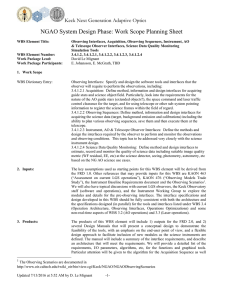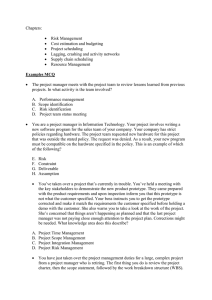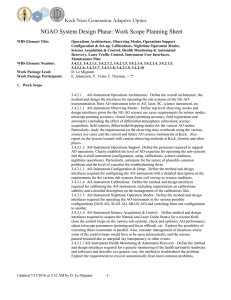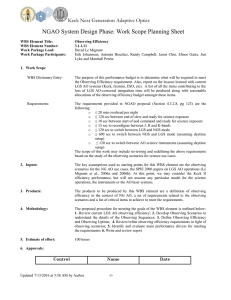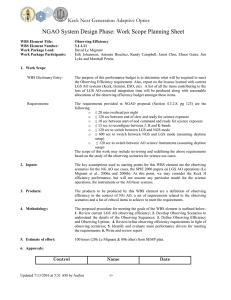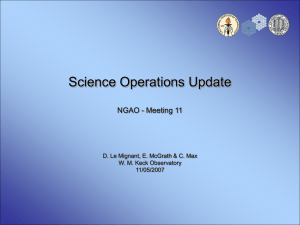NGAO System Design Phase: Work Scope Planning Sheet
advertisement
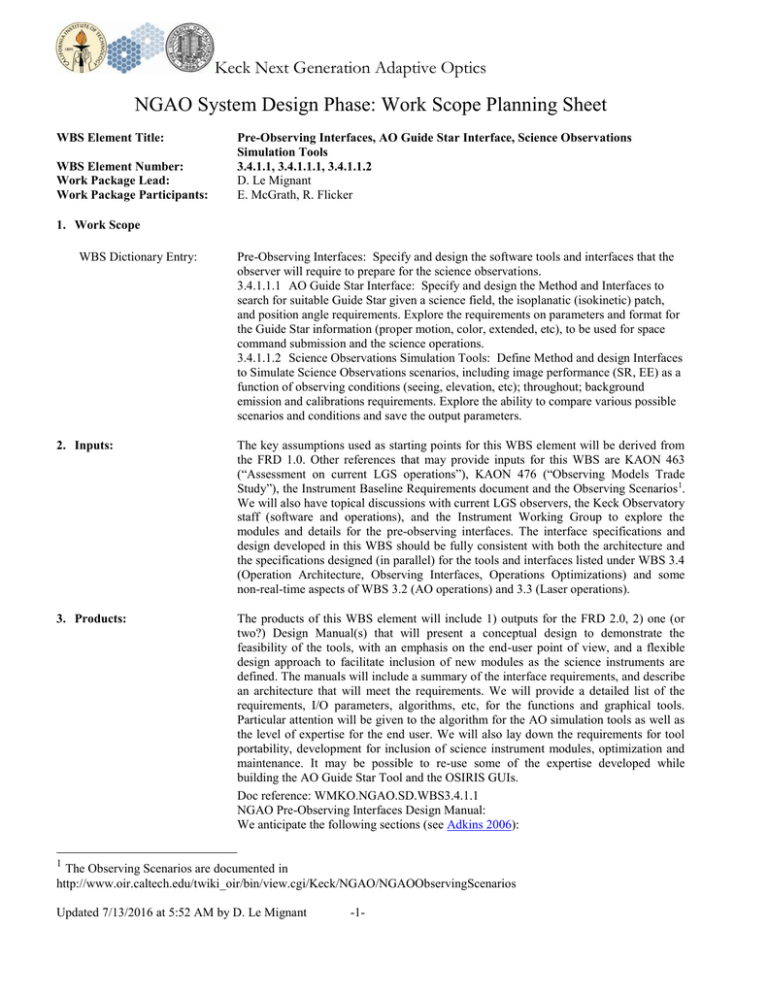
Keck Next Generation Adaptive Optics NGAO System Design Phase: Work Scope Planning Sheet WBS Element Title: WBS Element Number: Work Package Lead: Work Package Participants: Pre-Observing Interfaces, AO Guide Star Interface, Science Observations Simulation Tools 3.4.1.1, 3.4.1.1.1, 3.4.1.1.2 D. Le Mignant E. McGrath, R. Flicker 1. Work Scope WBS Dictionary Entry: Pre-Observing Interfaces: Specify and design the software tools and interfaces that the observer will require to prepare for the science observations. 3.4.1.1.1 AO Guide Star Interface: Specify and design the Method and Interfaces to search for suitable Guide Star given a science field, the isoplanatic (isokinetic) patch, and position angle requirements. Explore the requirements on parameters and format for the Guide Star information (proper motion, color, extended, etc), to be used for space command submission and the science operations. 3.4.1.1.2 Science Observations Simulation Tools: Define Method and design Interfaces to Simulate Science Observations scenarios, including image performance (SR, EE) as a function of observing conditions (seeing, elevation, etc); throughout; background emission and calibrations requirements. Explore the ability to compare various possible scenarios and conditions and save the output parameters. 2. Inputs: The key assumptions used as starting points for this WBS element will be derived from the FRD 1.0. Other references that may provide inputs for this WBS are KAON 463 (“Assessment on current LGS operations”), KAON 476 (“Observing Models Trade Study”), the Instrument Baseline Requirements document and the Observing Scenarios 1. We will also have topical discussions with current LGS observers, the Keck Observatory staff (software and operations), and the Instrument Working Group to explore the modules and details for the pre-observing interfaces. The interface specifications and design developed in this WBS should be fully consistent with both the architecture and the specifications designed (in parallel) for the tools and interfaces listed under WBS 3.4 (Operation Architecture, Observing Interfaces, Operations Optimizations) and some non-real-time aspects of WBS 3.2 (AO operations) and 3.3 (Laser operations). 3. Products: The products of this WBS element will include 1) outputs for the FRD 2.0, 2) one (or two?) Design Manual(s) that will present a conceptual design to demonstrate the feasibility of the tools, with an emphasis on the end-user point of view, and a flexible design approach to facilitate inclusion of new modules as the science instruments are defined. The manuals will include a summary of the interface requirements, and describe an architecture that will meet the requirements. We will provide a detailed list of the requirements, I/O parameters, algorithms, etc, for the functions and graphical tools. Particular attention will be given to the algorithm for the AO simulation tools as well as the level of expertise for the end user. We will also lay down the requirements for tool portability, development for inclusion of science instrument modules, optimization and maintenance. It may be possible to re-use some of the expertise developed while building the AO Guide Star Tool and the OSIRIS GUIs. Doc reference: WMKO.NGAO.SD.WBS3.4.1.1 NGAO Pre-Observing Interfaces Design Manual: We anticipate the following sections (see Adkins 2006): 1 The Observing Scenarios are documented in http://www.oir.caltech.edu/twiki_oir/bin/view.cgi/Keck/NGAO/NGAOObservingScenarios Updated 7/13/2016 at 5:52 AM by D. Le Mignant -1- Title Date 1. 2. 3. 4. 5. 6. Introduction Scope and Applicability Related Documents Revision History Overall System Requirements AO Guide Star Tools Requirements a. Performance Requirements i. Parametric ii. Operational b. Implementation Requirements i. Feature Implementation ii. Common Practices iii. Standards c. Design Requirements i. Technological ii. Standards Related iii. Integration Related 7. Science Observations Simulation Tools Requirements a. Performance Requirements i. Parametric ii. Operational b. Implementation Requirements i. Feature Implementation ii. Common Practices iii. Standards c. Design Requirements i. Technological ii. Standards Related iii. Integration Related 8. Interface Requirements 9. Reliability Requirements a. Risk and Mitigation 10. Service and Maintenance Requirements 11. Documentation Requirements 12. Glossary 4. Methodology: At this point, we propose the following procedure for meeting the goals of the WBS element. 1) Assemble and summarize the requirements from the referenced document above; 2) Document a preliminary design that will detail the architecture between tools from other WBS and includes functions, graphical tools and user interfaces for this WBS; 3) Provide a detailed description and/or discussion for each function supported by the Pre-Observing Interfaces. 5. Estimate of effort: The bulk of the work will be performed by D. Le Mignant (~36 h) as lead effort, in collaboration with E. McGrath (~12 h) for the “astronomer” end-user point of view and R. Flicker (~12 h) for the algorithm on the AO simulation tools and TBD for the interface with the science instrument tools. We would like the document to be reviewed by astronomers (or support astronomer) very familiar with using and building LGS observing tools for Keck, (e.g., A. Bouchez, astronomers sitting on the AOWG, etc.). 6. Approvals: 60 hours Updated 7/13/2016 at 5:52 AM by DLM 2 Title Date Control Name Date Authored by: David Le Mignant 10/05/07 Approved by: Don Gavel 10/11/07 Peter Wizinowich 10/11/07 Updated 7/13/2016 at 5:52 AM by DLM 3
